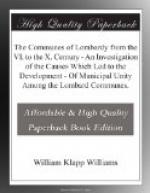Such then were the duties, the privileges and the restrictions of the first magistrate to whom we could venture to ascribe any of the attributes of a popular judge: a representative of the people at the assembly of their ruler; a judge of their suits and of their misdoings at home, and a check on the arbitrary power of their lord and feudal superior,—we can readily appreciate that the existence of such an officer within the city must have exercised some influence in giving to its inhabitants a greater sense of security, and consequently of importance, even if we cannot claim that in the earliest stages of municipal development it gave birth to any definite ideas of personal freedom or of municipal independence. But it can easily be seen that it formed another and an important factor in that idea whose progress we wish to trace, of a slowly growing feeling of individuality in the city as such, the municipal unit as conceived apart from the still legally recognized unit, the entire civitas. We have seen the count the representative of this idea as far as its actual connection with the constitution of the state was concerned, but it was the scabinus who was to represent it to the consciousness of the people, and to assist them in rediscovering the lost conception of a municipal unity.
It would be incomplete to conclude this account of the various officers of government, without some mention of the position held by the bishops at this period. As it has been our duty throughout this paper to study the municipalities of Italy as only preparing to assume a position of individuality eventually leading to independence, so it is with regard to the bishops. While their social influence, as pointed out in the first part of this paper, was always notable, their political power, which formed one of the important steps in the progress of the communes towards a separate existence, has its birth at a time which is beyond the limits of this investigation. Not until the overthrow




